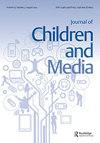Moral clarity decreases as viewer age increases: a content analysis of the moral values and reinforcement cues depicted in popular U.S. children’s television
IF 2.1
3区 心理学
Q2 COMMUNICATION
引用次数: 7
Abstract
ABSTRACT Evidence suggests that exposure to narrative media content emphasizing the importance of moral intuitions can increase the extent to which children value those intuitions. This is especially the case when intuition exemplars are accompanied by clear social desirability cues (i.e., moral acts are rewarded/performed by heroes or immoral acts are punished/performed by villains). Less is known about the effects of exposure to ambiguous social desirability cues (i.e., moral acts are punished/performed by villains or immoral acts are rewarded/performed by heroes). In order to investigate the extent to which popular media content may serve as an effective moral educator for young viewers, this paper describes a content analysis designed to examine the frequency and clarity of moral intuition exemplars in popular children’s television shows (N = 30). Results demonstrated that moral clarity in content decreased as viewer age increased. That is, content popular among older children (ages 6–17) featured more ambiguous social desirability cues compared to content popular among younger children (ages 2–5). Content across age groups also featured a preponderance of care and fairness intuition exemplars. Findings are interpreted in line with extant research on moral complexity and narrative entertainment. Practical implications are considered. IMPACT SUMMARY a. Prior State of Knowledge Recent work has demonstrated that narrative media’s emphasis on moral intuitions can increase the importance audiences place on those intuitions. This work largely focuses on understanding the effects of moral exemplars that are clearly reinforced in narratives. b. Novel Contributions Using content analysis, the present study demonstrated that the clarity of narrative reinforcement cues decreases as the age group in which the content is popular increases. Specifically, moral exemplars in television shows popular among teens featured the most ambiguous reinforcement cues. c. Practical Implications For caregivers hoping to use media as a tool for inculcating certain moral values in children, these results suggest the importance of considering not only which moral values are exemplified in content, but also how clearly those values are reinforced.道德清晰度随着观众年龄的增长而下降:美国流行儿童电视节目中描述的道德价值观和强化线索的内容分析
有证据表明,接触强调道德直觉重要性的叙事媒体内容可以增加儿童对这些直觉的重视程度。当直觉范例伴随着明确的社会期望线索时尤其如此(例如,英雄奖励/执行道德行为,恶棍惩罚/执行不道德行为)。暴露于模棱两可的社会欲望线索(即,道德行为受到恶棍的惩罚/执行,不道德行为受到英雄的奖励/执行)的影响知之甚少。为了调查流行媒体内容在多大程度上可以作为年轻观众有效的道德教育者,本文描述了一项内容分析,旨在检查流行儿童电视节目中道德直觉范例的频率和清晰度(N = 30)。结果表明,随着观众年龄的增加,内容的道德清晰度下降。也就是说,与受年龄较大的儿童(6-17岁)欢迎的内容相比,受年龄较小的儿童(2-5岁)欢迎的内容具有更模糊的社会可取性线索。跨年龄组的内容也以关怀和公平直觉范例为主。研究结果的解释与现有的关于道德复杂性和叙事娱乐的研究一致。考虑了实际影响。最近的研究表明,叙事媒体对道德直觉的强调可以增加受众对这些直觉的重视。这项工作主要集中在理解在叙事中明显加强的道德榜样的影响。使用内容分析,本研究表明,随着内容受欢迎的年龄组的增加,叙事强化线索的清晰度降低。具体来说,在青少年中流行的电视节目中的道德榜样具有最模糊的强化线索。对于希望利用媒体作为工具向儿童灌输某些道德价值观的照顾者来说,这些结果表明,不仅要考虑哪些道德价值观在内容中得到体现,还要考虑这些价值观得到加强的程度。
本文章由计算机程序翻译,如有差异,请以英文原文为准。
求助全文
约1分钟内获得全文
求助全文

 求助内容:
求助内容: 应助结果提醒方式:
应助结果提醒方式:


